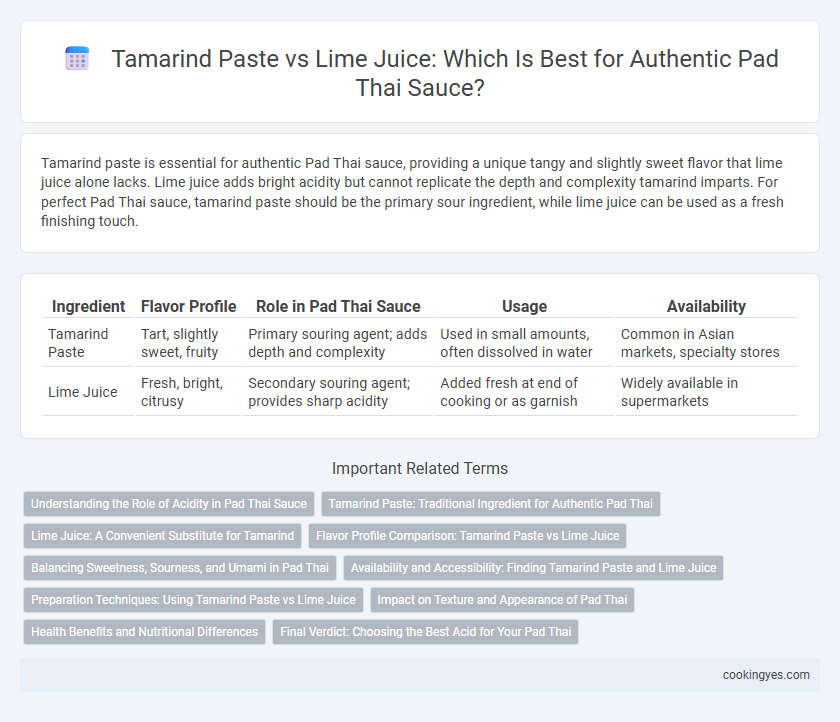Tamarind paste is essential for authentic Pad Thai sauce, providing a unique tangy and slightly sweet flavor that lime juice alone lacks. Lime juice adds bright acidity but cannot replicate the depth and complexity tamarind imparts. For perfect Pad Thai sauce, tamarind paste should be the primary sour ingredient, while lime juice can be used as a fresh finishing touch.
Table of Comparison
| Ingredient | Flavor Profile | Role in Pad Thai Sauce | Usage | Availability |
|---|---|---|---|---|
| Tamarind Paste | Tart, slightly sweet, fruity | Primary souring agent; adds depth and complexity | Used in small amounts, often dissolved in water | Common in Asian markets, specialty stores |
| Lime Juice | Fresh, bright, citrusy | Secondary souring agent; provides sharp acidity | Added fresh at end of cooking or as garnish | Widely available in supermarkets |
Understanding the Role of Acidity in Pad Thai Sauce
Tamarind paste provides a deep, fruity acidity essential for balancing the sweet and savory flavors in Pad Thai sauce, creating its characteristic tangy foundation. Lime juice offers a sharper and more citrusy acidity, which can brighten the sauce but may lack the complex sourness that tamarind contributes. Understanding this difference is crucial for achieving the authentic flavor profile that defines traditional Pad Thai.
Tamarind Paste: Traditional Ingredient for Authentic Pad Thai
Tamarind paste is the essential traditional ingredient that defines the authentic tangy and slightly sweet flavor of Pad Thai sauce, offering a depth and richness that lime juice alone cannot replicate. Its natural acidity and fruity complexity balance the savory and sweet elements, creating the signature taste unique to classic Pad Thai recipes. While lime juice adds fresh citrus notes, tamarind paste provides a more robust and rounded sourness critical for achieving genuine Thai culinary heritage.
Lime Juice: A Convenient Substitute for Tamarind
Lime juice offers a convenient substitute for tamarind paste in Pad Thai sauce, providing a bright, tangy flavor that balances the dish's sweet and savory notes. While tamarind paste delivers a deeper, more complex sourness, lime juice's acidity enhances freshness and is more readily available in most kitchens. Using lime juice simplifies preparation without compromising the essential zest that defines authentic Pad Thai.
Flavor Profile Comparison: Tamarind Paste vs Lime Juice
Tamarind paste delivers a rich, tangy, and slightly sweet flavor essential to authentic Pad Thai sauce, creating a deep umami complexity. Lime juice offers a brighter, fresher acidity with citrus notes, enhancing brightness but lacking tamarind's depth and subtle sweetness. Using tamarind paste results in a more balanced, traditional flavor profile, while lime juice provides a sharper, more straightforward sourness.
Balancing Sweetness, Sourness, and Umami in Pad Thai
Tamarind paste provides a rich, tangy depth that enhances the umami and sourness in Pad Thai sauce, creating a balanced flavor profile that complements the dish's natural sweetness. Lime juice offers a sharp, fresh acidity that brightens the sauce but lacks the complexity of tamarind's earthy undertones. Combining tamarind paste with a splash of lime juice achieves an ideal harmony of sweetness, sourness, and umami, essential for authentic Pad Thai taste.
Availability and Accessibility: Finding Tamarind Paste and Lime Juice
Tamarind paste is a traditional and essential ingredient in authentic Pad Thai sauce, often available in Asian supermarkets and online specialty stores, but it may be less accessible in general grocery stores. Lime juice, a common citrus product, is widely available in most supermarkets and serves as a convenient substitute, although it lacks the unique tangy depth that tamarind provides. For home cooks seeking authentic flavor, sourcing tamarind paste through international food markets ensures better accessibility to this key ingredient.
Preparation Techniques: Using Tamarind Paste vs Lime Juice
Tamarind paste provides the essential tangy depth and rich complexity in Pad Thai sauce, achieved through careful extraction from tamarind pods and straining to remove fibers. Lime juice contributes brightness and fresh acidity but lacks the thick, syrupy consistency that tamarind paste imparts. Preparation techniques favor tamarind paste for authentic texture and balanced sourness, while lime juice is commonly added later as a finishing touch to enhance freshness.
Impact on Texture and Appearance of Pad Thai
Tamarind paste contributes a thick, rich texture and deep amber color that enhances the glossy appearance of authentic Pad Thai sauce. Lime juice, while brightening the flavor with its citrus acidity, results in a thinner sauce that lacks the characteristic viscosity and muted hue critical for traditional presentation. The choice between tamarind paste and lime juice directly affects the dish's mouthfeel and visual appeal, with tamarind offering a more cohesive and visually appetizing coating on noodles.
Health Benefits and Nutritional Differences
Tamarind paste, rich in antioxidants and vitamin C, supports digestion and offers anti-inflammatory properties, making it a healthy choice for Pad Thai sauce. Lime juice provides a high vitamin C content and promotes immune health while containing fewer calories and sugars than tamarind paste. Both ingredients contribute unique nutritional benefits, with tamarind enhancing fiber intake and lime juice aiding in hydration and weight management.
Final Verdict: Choosing the Best Acid for Your Pad Thai
Tamarind paste delivers a rich, tangy depth essential for authentic Pad Thai, balancing sweetness and spice with a complex, fruity flavor that lime juice lacks. Lime juice offers a fresher, sharper acidity, ideal for a lighter, more citrus-forward sauce but may overpower traditional Pad Thai's nuanced taste. Opt for tamarind paste to achieve the classic, well-rounded Pad Thai sauce, reserving lime juice as a complementary finish or garnish.
Tamarind paste vs lime juice for Pad Thai sauce Infographic

 cookingyes.com
cookingyes.com